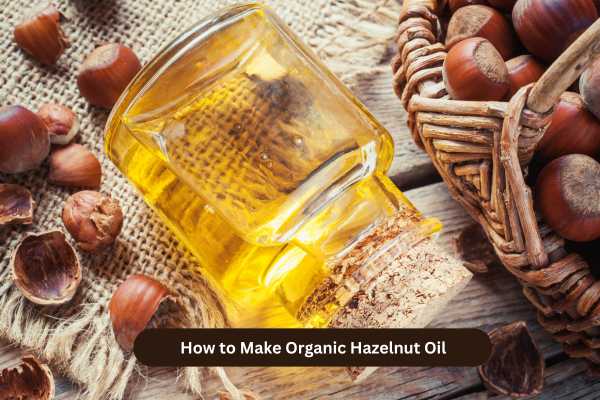Organic hazelnut oil is a luxurious and nutrient-rich oil, known for its light texture, nutty aroma, and skin-friendly properties. It’s widely used in cooking, skincare, and natural remedies. But did you know you can make your own organic hazelnut oil at home? It’s easier than you think—and doing it yourself ensures purity, freshness, and zero unwanted additives.

In this professional guide tailored for UK readers, we’ll walk you through how to make organic hazelnut oil using whole hazelnuts, focusing on natural methods. We’ll follow Google NLP and semantic SEO guidelines, delivering clear, informative, and search-optimised content.
Why Choose Organic Hazelnut Oil?
Hazelnut oil is cold-pressed from the kernels of hazelnuts and offers multiple benefits. It’s rich in healthy fats, vitamin E, and antioxidants. When made organically, without chemicals or artificial preservatives, it retains more nutrients and is safer for consumption and skincare.
In the UK, organic oils are gaining popularity due to rising awareness of natural living and sustainable choices. Making your own hazelnut oil helps eliminate plastic waste, reduce your carbon footprint, and avoid refined commercial products.
What You’ll Need
To make organic hazelnut oil, you’ll need only a few ingredients and tools:
Ingredients:
-
2 cups organic raw hazelnuts (preferably shelled and skinless)
Equipment:
-
High-speed blender or food processor
-
Nut milk bag or fine mesh strainer
-
Glass jar or bottle (for storage)
-
Optional: cold oil press machine (for a professional cold-pressed method)
Make sure to use certified organic hazelnuts. You can find these in most UK health food stores or online organic suppliers.
Method 1: Blender or Food Processor Technique
This is a simple method suitable for home kitchens, especially if you don’t own an oil press.
Step 1: Roast the Hazelnuts (Optional)
Roasting enhances the nutty flavour and can help release more oil during blending. Preheat your oven to 175°C (350°F) and roast the hazelnuts on a baking tray for 10–12 minutes. Allow them to cool before processing.
Note: Skip roasting if you prefer raw, cold-pressed style oil.
Step 2: Blend the Hazelnuts
Place the hazelnuts in your blender or food processor. Blend on high speed for 8–10 minutes, stopping occasionally to scrape down the sides. The nuts will first become a meal, then turn into a paste, and finally begin to release oil.
You’ll know it’s working when the mixture looks shiny and starts to separate.
Step 3: Strain the Oil
Scoop the hazelnut paste into a nut milk bag or fine mesh strainer over a bowl. Press and squeeze to extract as much oil as possible. This process can take a few minutes, but be patient—the reward is fresh, aromatic oil.
Step 4: Store Properly
Pour the strained hazelnut oil into a clean, dry glass jar or bottle. Seal tightly and store in a cool, dark place. For maximum shelf life (up to 6 months), refrigerate the oil.
Method 2: Cold Press Machine (Advanced)
If you’re serious about home oil extraction and want a more authentic cold-press method, consider investing in a manual or electric oil press machine. These are available from several UK retailers.
How It Works:
-
Insert raw organic hazelnuts into the oil press.
-
Turn the handle or operate the machine as per instructions.
-
Collect the fresh oil and filter it through a fine sieve or muslin cloth.
-
Bottle and refrigerate for freshness.
Cold-press machines maintain low temperatures, preserving all the essential fatty acids and nutrients, ideal for cosmetic and culinary uses.
Uses of Organic Hazelnut Oil
Homemade organic hazelnut oil is incredibly versatile:
-
Culinary: Use it as a finishing oil on salads, roasted vegetables, or desserts. It adds a subtle nutty flavour.
-
Skincare: Apply directly to the skin as a natural moisturiser or mix with essential oils for massage.
-
Haircare: Rub a few drops into the scalp or hair ends for added shine and hydration.
Since it’s free from chemicals, it’s perfect for those with sensitive skin or allergies.
Tips for Best Results
-
Use fresh, organic nuts only. Old or stale hazelnuts can result in bitter oil.
-
Sterilise storage jars to prevent contamination.
-
Do not heat the oil after extraction—it’s meant for cold use only.
-
Label and date your jar so you remember when it was made.
Sustainability and Cost
Making hazelnut oil at home is eco-friendly. You avoid plastic packaging, reduce food waste, and gain complete transparency over what goes into your oil. While buying organic hazelnut oil in the UK can be expensive, DIY methods often cost less in the long run, especially if you purchase nuts in bulk.
Final Thoughts
Making organic hazelnut oil at home is a rewarding and straightforward process. Whether you use a blender or a cold press machine, you’ll end up with a fresh, chemical-free oil that’s full of natural goodness. It’s perfect for enhancing both your recipes and your natural beauty routine.
By crafting your own oil, you not only prioritise your health and well-being but also contribute to a more sustainable lifestyle—something increasingly important to conscious consumers in the UK.

